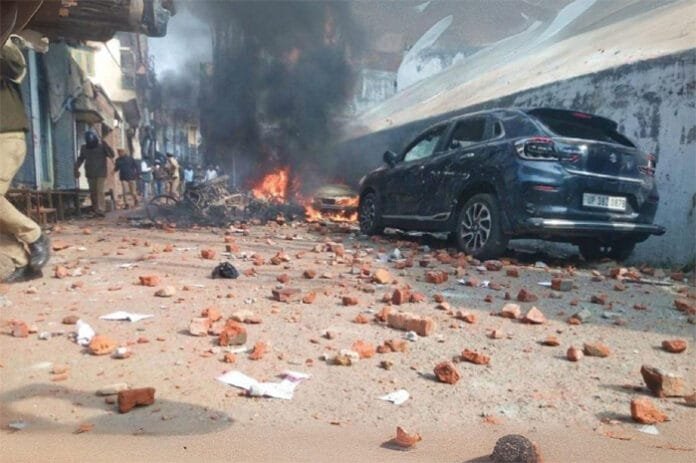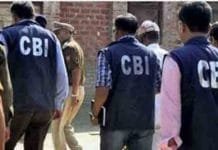The recent violence surrounding the Jama Masjid in Sambhal has sparked nationwide attention, as authorities intensify their response against those responsible. A systematic and stringent investigation is underway, ensuring that all involved are brought to justice under the National Security Act (NSA). Here, we delve into the incident’s details, the ongoing police efforts, and the gravity of the situation that has impacted the community and law enforcement.
Stone Pelting During Jama Masjid Survey: What Happened?
On a quiet Sunday morning, a court-mandated survey of the Jama Masjid turned into chaos when an unruly mob disrupted the proceedings. As the police team initiated the survey, a large crowd began gathering outside the mosque. What started as minor unrest quickly escalated into widespread violence, with stones hurled at the police personnel and women participating from the rooftops.
The mob’s aggressive actions weren’t limited to stone pelting. Gunfire targeted at police officers heightened the severity of the situation. Despite the violence, the police team remained steadfast, secretly capturing video evidence of the incident to aid in identifying the perpetrators. Tragically, three individuals lost their lives, and several law enforcement officers sustained injuries.
CCTV Footage and Mobile Videos: Unmasking the Culprits
The Sambhal police administration is leaving no stone unturned in identifying the miscreants. CCTV cameras installed throughout the streets are being thoroughly examined to extract relevant footage. These recordings, combined with videos captured on police personnel’s mobile phones, are playing a pivotal role in identifying the individuals involved in the violence.
SP Krishna Kumar Vishnoi affirmed that comprehensive efforts are underway to track down every participant in the chaos. “No accused will be spared,” he emphasized, reiterating the administration’s zero-tolerance policy for such disruptive actions.
National Security Act to Be Enforced
Authorities have decided to invoke the National Security Act (NSA) against the miscreants. The NSA is a powerful legal tool designed to address situations that threaten public order or national security. Under its provisions, individuals can be detained for extended periods without formal charges, ensuring swift and decisive action against those who disturb communal harmony.
This tough stance reflects the gravity of the situation and the government’s commitment to maintaining law and order. DIG Muniraj Ji echoed similar sentiments, stating that strict action would be taken against the stone pelters and any individual involved in orchestrating or participating in the violence.
Impact of Violence on the Local Community
The Jama Masjid incident has had profound implications for the Sambhal community. Fear and uncertainty now linger among residents who were shocked by the intensity of the violence. Local businesses and daily activities in the vicinity have been disrupted, with many residents calling for stringent measures to restore peace and prevent such occurrences in the future.
Religious leaders and community representatives are urging calm and cooperation with law enforcement agencies. They stress the importance of fostering a spirit of communal harmony to ensure that such violent incidents do not mar Sambhal’s social fabric again.
The Role of Women in the Unrest
One of the more striking aspects of this incident was the involvement of women pelting stones from rooftops. This calculated move added complexity to the situation, as it suggested a level of premeditation and coordination. The police have gathered video evidence highlighting this involvement, and those identified will also face strict legal action.
Law Enforcement’s Preparedness and Future Steps
The Jama Masjid violence underscores the importance of proactive measures to prevent such occurrences during sensitive operations. Law enforcement agencies are already evaluating their handling of the situation and implementing strategies to enhance preparedness in future.
Key Actions by the Police:
- Thorough Investigation: Teams are meticulously analyzing CCTV and video evidence to ensure all culprits are identified and apprehended.
- Community Outreach: Local police are engaging with community leaders to promote dialogue and discourage further unrest.
- Deployment of Forces: Additional personnel have been stationed in sensitive areas to prevent any retaliatory violence or escalation.
- Legal Proceedings: Stringent cases are being filed against the accused, with the NSA invoked to ensure swift and severe consequences.
Historical Context of Mosque Surveys in India
The survey at Jama Masjid, conducted on court orders, is part of a broader trend of judicial interventions in religious sites. Such surveys are often undertaken to resolve disputes or assess structural concerns. However, these operations can become flashpoints for communal tension, as seen in Sambhal.
In recent years, mosques across India have been subject to similar surveys, with mixed reactions from local communities. The Sambhal incident serves as a reminder of the importance of fostering transparency, dialogue, and respect during such sensitive procedures.
Government’s Stance on Ensuring Law and Order
The Indian government has reiterated its commitment to safeguarding national security and public peace. By invoking the NSA, authorities send a strong message that actions disrupting public order will not be tolerated. This move is expected to deter potential miscreants from engaging in similar activities in the future.
Conclusion: A Firm Stand Against Violence
The Jama Masjid violence in Sambhal has brought into sharp focus the need for strict enforcement of laws to maintain peace and order. With authorities leveraging every available resource, including video evidence and the National Security Act, justice for the victims and the restoration of communal harmony seem inevitable.
As the investigation progresses, the resolve of the police and administration will play a crucial role in ensuring that such incidents do not recur. Sambhal’s residents, as well as the nation, await a conclusion that reflects the principles of justice, accountability, and unity.
















